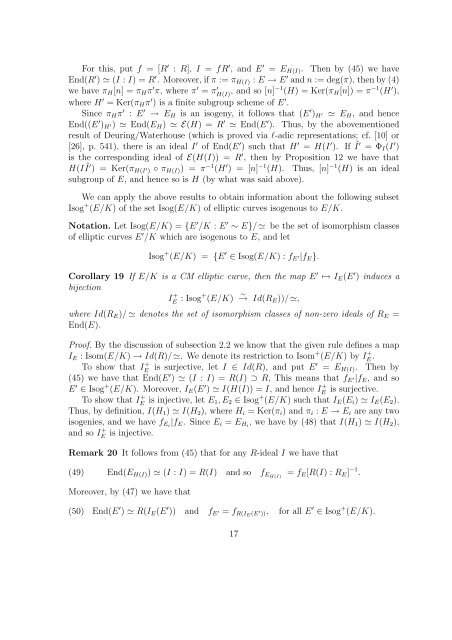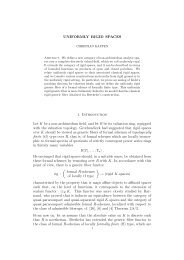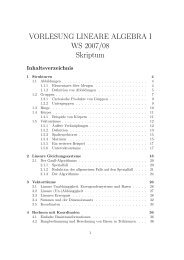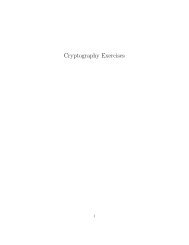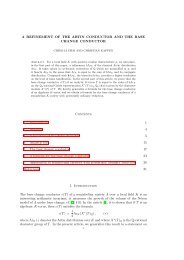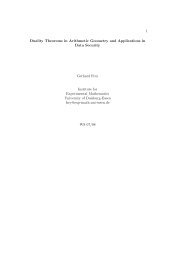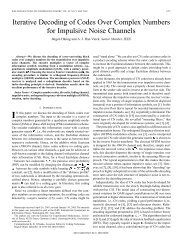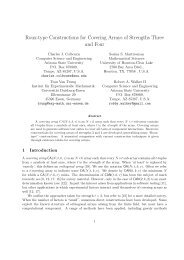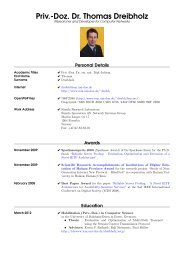3 <strong>CM</strong> <strong>elliptic</strong> <strong>curves</strong>3.1 Kernel ideals and ideal subgroupsWe now apply the theory <strong>of</strong> the previous section to the case that A = E is <strong>elliptic</strong>curve over K with complex multiplication. By this we mean that E/K is an <strong>elliptic</strong>curve such thatEnd 0 (E) = End 0 (E ⊗ K) = Fis an imaginary quadratic field F , where K denotes the algebraic closure <strong>of</strong> K. Notethat this definition is slightly more restrictive than that <strong>of</strong> (say) [18], since we assumehere that all K-endomorphisms are already defined over K.If E/K is a <strong>CM</strong> <strong>elliptic</strong> curve, then R = End(E) is an order in F . Thus, Ris uniquely characterized by its conductor f E := [O F : R] or by its discriminant∆ E := ∆(R), which we call the conductor and discriminant <strong>of</strong> E, respectively.The main results about kernel ideals and ideal subgroups are summarized in thefollowing theorem which can be viewed as a refinement <strong>of</strong> results <strong>of</strong> Deuring[10] andWaterhouse[26].Theorem 18 Let E/K be a <strong>CM</strong> <strong>elliptic</strong> curve and R = End(E). Then:(a) Every non-zero R-ideal I is a kernel ideal. Thus(45)Φ I1 ,I 2:= Φ H(I1 ),H(I 2 ) : Hom(E H(I1 ), E H(I2 ))∼→ (I 1 : I 2 )is an isomorphism for all non-zero ideals I 1 , I 2 <strong>of</strong> R.(b) If H be a finite subgroup scheme <strong>of</strong> E, then(46)H is an ideal subgroup ⇔ f EH |f E .Thus, if H 1 , H 2 are finite subgroup schemes <strong>of</strong> E such that f EHi |f E , for i = 1, 2, then(47)Φ H1 ,H 2: Hom(E H1 , E H2 )∼→ H(H 1 , H 2 ) = (I(H 1 ) : I(H 2 )),and we have(48)E H1 ≃ E H2 ⇔ I(H 1 ) ≃ I(H 2 ).Pro<strong>of</strong>. (a) This is a special case <strong>of</strong> Proposition 15.(b) We first observe that it is enough to verify (46), for then (47) follows immediatelyfrom Proposition 10 and (48) follows from (21).To prove (46), we first note that since E(H) ≃ End(E H ), it follows from (37) thatf EH |f E ⇔ R ⊂ E(H). Thus, the one direction (⇒) follows directly from Corollary 11.Conversely, suppose that f EH |f E or, equivalently, that R ⊂ R ′ := E(H). By (15)it is enough to show that H n := [n] −1 (H) is an ideal subgroup, for some n ∈ N.16
For this, put f = [R ′ : R], I = fR ′ , and E ′ = E H(I) . Then by (45) we haveEnd(R ′ ) ≃ (I : I) = R ′ . Moreover, if π := π H(I) : E → E ′ and n := deg(π), then by (4)we have π H [n] = π H π ′ π, where π ′ = πH(I) ′ , and so [n]−1 (H) = Ker(π H [n]) = π −1 (H ′ ),where H ′ = Ker(π H π ′ ) is a finite subgroup scheme <strong>of</strong> E ′ .Since π H π ′ : E ′ → E H is an isogeny, it follows that (E ′ ) H ′ ≃ E H , and henceEnd((E ′ ) H ′) ≃ End(E H ) ≃ E(H) = R ′ ≃ End(E ′ ). Thus, by the abovementionedresult <strong>of</strong> Deuring/Waterhouse (which is proved via l-adic representations; cf. [10] or[26], p. 541), there is an ideal I ′ <strong>of</strong> End(E ′ ) such that H ′ = H(I ′ ). If Ĩ′ = Φ I (I ′ )is the corresponding ideal <strong>of</strong> E(H(I)) = R ′ , then by Proposition 12 we have thatH(IĨ′ ) = Ker(π H(I ′ ) ◦ π H(I) ) = π −1 (H ′ ) = [n] −1 (H). Thus, [n] −1 (H) is an idealsubgroup <strong>of</strong> E, and hence so is H (by what was said above).We can apply the above results to obtain information about the following subsetIsog + (E/K) <strong>of</strong> the set Isog(E/K) <strong>of</strong> <strong>elliptic</strong> <strong>curves</strong> isogenous to E/K.Notation. Let Isog(E/K) = {E ′ /K : E ′ ∼ E}/ ≃ be the set <strong>of</strong> isomorphism classes<strong>of</strong> <strong>elliptic</strong> <strong>curves</strong> E ′ /K which are isogenous to E, and letIsog + (E/K) = {E ′ ∈ Isog(E/K) : f E ′|f E }.Corollary 19 If E/K is a <strong>CM</strong> <strong>elliptic</strong> curve, then the map E ′ ↦→ I E (E ′ ) induces abijectionI + E : Isog+ ∼(E/K) → Id(R E ))/≃,where Id(R E )/ ≃ denotes the set <strong>of</strong> isomorphism classes <strong>of</strong> non-zero ideals <strong>of</strong> R E =End(E).Pro<strong>of</strong>. By the discussion <strong>of</strong> subsection 2.2 we know that the given rule defines a mapI E : Isom(E/K) → Id(R)/≃. We denote its restriction to Isom + (E/K) by I + E .To show that I + E is surjective, let I ∈ Id(R), and put E′ = E H(I) . Then by(45) we have that End(E ′ ) ≃ (I : I) = R(I) ⊃ R, This means that f E ′|f E , and soE ′ ∈ Isog + (E/K). Moreover, I E (E ′ ) ≃ I(H(I)) = I, and hence I + Eis surjective.To show that I + E is injective, let E 1, E 2 ∈ Isog + (E/K) such that I E (E i ) ≃ I E (E 2 ).Thus, by definition, I(H 1 ) ≃ I(H 2 ), where H i = Ker(π i ) and π i : E → E i are any twoisogenies, and we have f Ei |f E . Since E i = E Hi , we have by (48) that I(H 1 ) ≃ I(H 2 ),and so I + Eis injective.Remark 20 It follows from (45) that for any R-ideal I we have that(49)End(E H(I) ) ≃ (I : I) = R(I) and so f EH(I) = f E [R(I) : R E ] −1 .Moreover, by (47) we have that(50)End(E ′ ) ≃ R(I E (E ′ )) and f E ′ = f R(IE (E ′ )), for all E ′ ∈ Isog + (E/K).17
- Page 1: Products of CM elliptic curves1 Int
- Page 7 and 8: Indeed, if If is a kernel ideal, th
- Page 9 and 10: Indeed, by (18) we have I 1 f = I 2
- Page 11 and 12: Proof. To prove (29), let h ∈ Hom
- Page 13 and 14: 2.4 The quadratic caseWe now specia
- Page 15: ecause here f 2 |f 1 , so f = f 2 a
- Page 19 and 20: From (54) we can conclude that(55)d
- Page 21 and 22: If H is any finite subgroup scheme
- Page 23 and 24: E. As we shall see, it is very illu
- Page 25 and 26: From this we see on the one hand th
- Page 27 and 28: Proposition 30 Let L ∈ Lat F , wh
- Page 29 and 30: (b) Deuring[10], p. 263. Note that
- Page 31 and 32: integral quadratic formq L,α,β (x
- Page 33 and 34: Corollary 39 Let E 1 /K and E 2 /K
- Page 35 and 36: Proof. Write π i = π Hi : A → A
- Page 37 and 38: (a) The order R is cyclic if and on
- Page 39 and 40: for k = 1, . . . , n − 2. Moreove
- Page 41 and 42: 4.3 Products of CM elliptic curvesW
- Page 43 and 44: Corollary 56 Let E/K be a CM ellipt
- Page 45 and 46: Case 2. char(K) = 0.As was mentione
- Page 47 and 48: Let h A/K (X) ∈ Z[X] (respectivel
- Page 49 and 50: Proof. To prove this, we shall use
- Page 51 and 52: where xy denotes the quadratic form
- Page 53 and 54: denote the set of isomorphism class


